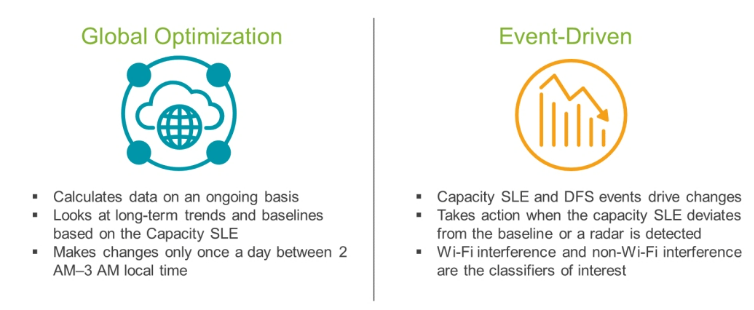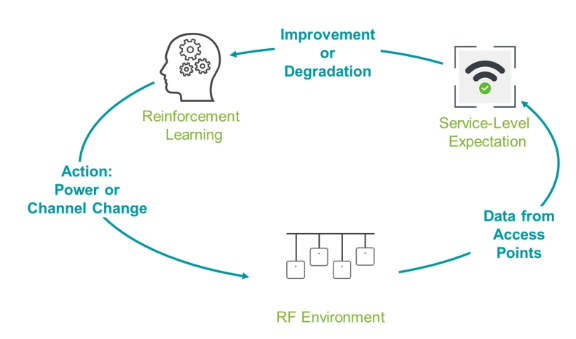EMAIL SUPPORT
dclessons@dclessons.comLOCATION
USJuniper Mist's Radio Resource Management
Radio Resource Management
Juniper MistTM has two radio resource management (RRM) systems running in parallel. Cross-collation occurs across all sites within an organization:
- Global Optimization — The global optimization system considers long-term statistics and baselines to optimize the channel and power setting across a site. These changes are only made once a day during low usage time.
- Event-Driven — The event-driven system is also known as local RRM. It triggers channel-level and power-level changes on a signal access point (AP) when an event occurs. This event could either be radar detection on the AP or the deviation of capacity service-level expectation (SLE) from its baseline because of Wi-Fi interference or non–Wi-Fi interference.

Reinforcement Learning
Artificial intelligence (AI) can be leveraged with RRM to deliver a better user experience and overall operational efficiency. One of the core elements is called reinforcement learning. This works on the principle that an agent takes an action that is penalized or rewarded based on the result to reinforce the optimal behavior. This is like how toddlers and robots learn to walk, whereby the penalty of falling down enforces proper behavior such as smaller steps and attention to balance.

In a Wi-Fi network, the action would be a change in the channel and (or) transmit power. The state is determined by key domain classifiers that measure the SLE, such as capacity, coverage, and dynamic frequency selection (DFS) radar event occurrences. The result would be an improvement or degradation in the capacity and (or) coverage. The system should ultimately optimize the SLEs, and thus the user experience over time. Its learning is reinforced to select the optimal actions.
Dynamic Frequency Selection
Dynamic frequency selection is a technology only available in the 5-GHz bands. Dynamic frequency selection is used to detect radar use on a channel. When detected by an AP, it sends out a channel switch announcement frame to inform the clients it's moving channels and also what channel it’s moving to. Whenever a device moves channels in a DFS range, it needs to perform a channel availability check that forces the AP to listen on that channel to verify there is no radar present.

In the U.S., it's a 60-second wait and in Europe it's 10 minutes. If radar is detected on a channel, the AP cannot change back to that channel for a minimum of 30 minutes.
RRM Configuration
RRM configuration is found at Site > Wireless > Radio Management. Here, you can toggle between the 2.4-GHz, 5-GHz, and 6-GHz radio settings for further manual configuration. The default configuration is for RRM to automatically choose power and channels based upon its supporting algorithms. Juniper Mist RRM also has an auto-conversion or cancellation feature. When enabled, this feature enables RRM to disable 2.4-GHz as needed. This prevents additional interference in high-density 2.4-GHz environments.
When APs are deployed close enough, such that some APs can cumulatively provide enough coverage for the area (high-density deployments), and this option is configured, then RRM may reduce interference by disabling the redundant 2.4-GHz radios for non-dual band APs. With dual band APs (that is, AP43 and AP63), RRM may instead move the dual band radio to the 5-GHz band. In the RF Templates and Device Profiles pages, enabling Auto in the Dual Band Radio Config box enables Auto Conversion for the dual band AP models, and Auto Cancellation for the rest of the APs. radio frequency (RF) templates can be configured and deployed to specific AP models or the entire site.





LEAVE A COMMENT
Please login here to comment.